Key takeaways:
- Regenerative agriculture aims to restore ecosystems by enhancing soil fertility, biodiversity, and water cycles, offering a holistic approach to sustainable food production.
- Key practices include agroforestry, crop diversity, and integrating livestock, which promote healthier environments and more resilient farming systems.
- Challenges in implementation involve initial resource investment, community skepticism, and unpredictability of weather impacting agricultural outcomes.
- The future of regenerative agriculture relies on collaboration, technology integration, and increasing consumer demand for sustainable products to drive widespread adoption.
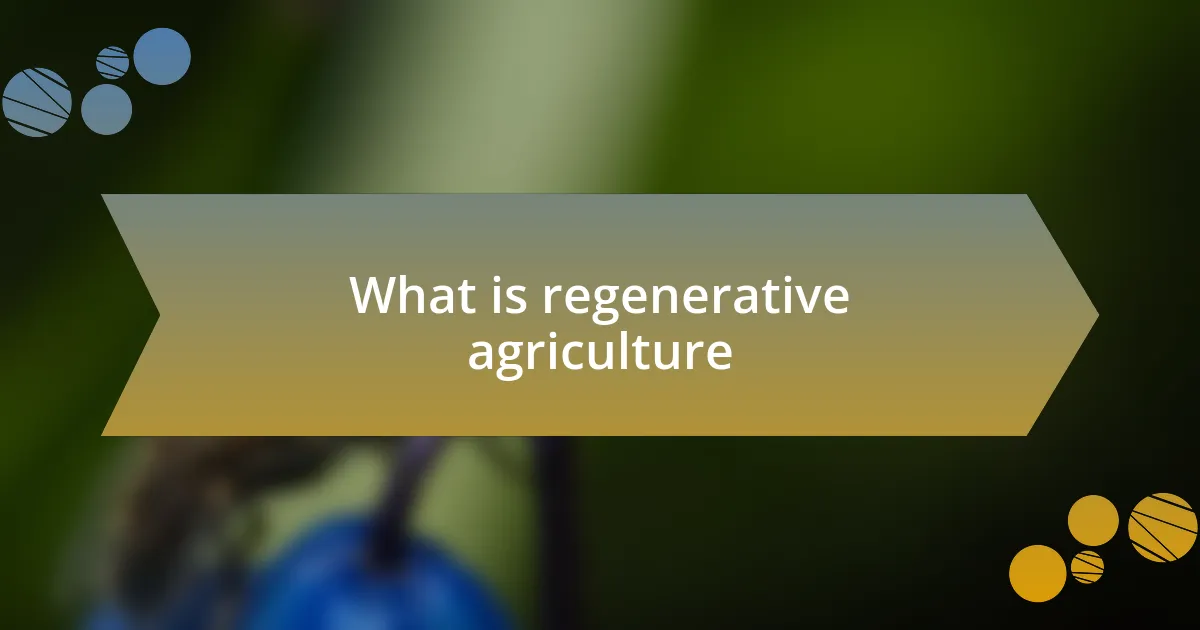
What is regenerative agriculture
Regenerative agriculture is a holistic farming practice that aims to restore and enhance the health of ecosystems while producing food. It goes beyond sustainability; it focuses on rebuilding soil fertility, increasing biodiversity, and improving water cycles. When I first encountered the concept, I wondered how something simple could be so transformative for our planet.
One example of regenerative practices is agroforestry, where trees and shrubs are integrated with crops and livestock. I recall visiting a farm that employed this technique, and I was awestruck by how lush and vibrant the land appeared. It was clear to me that the interconnectedness of various species not only benefited the environment but also created a more resilient farming system.
This approach often leads to improved yield over time, reducing the need for chemical fertilizers and pesticides. It makes me think, shouldn’t we all strive for a farming method that nurtures the earth while feeding us? The beauty of regenerative agriculture lies in its potential to create a cycle of flourishing life, both on the land and within our communities.
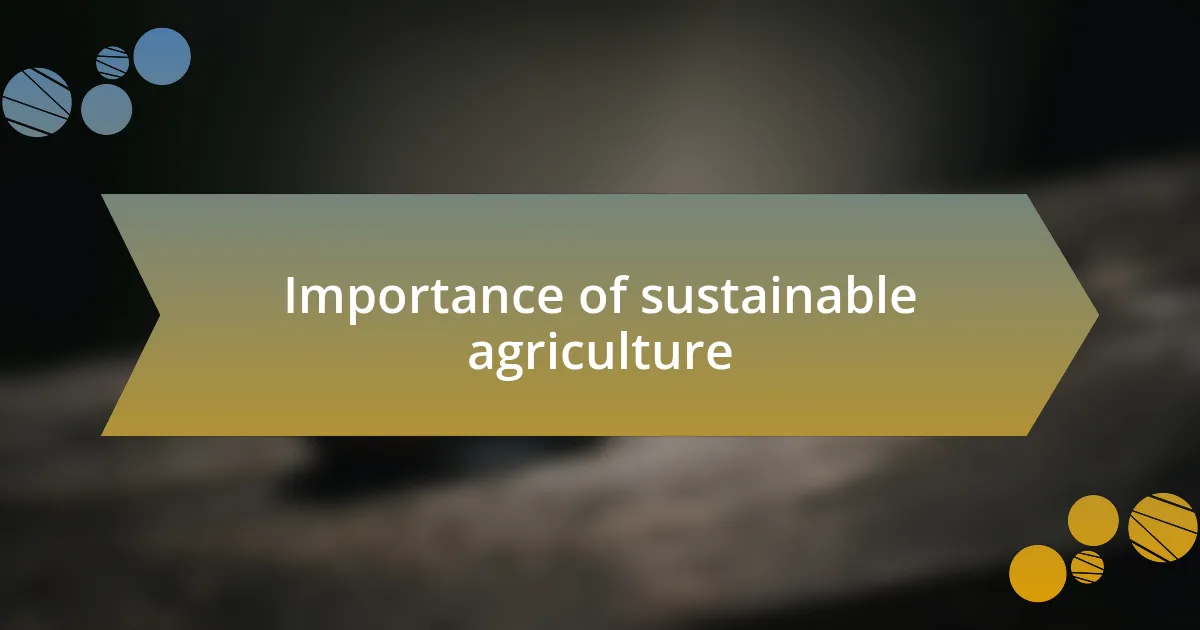
Importance of sustainable agriculture
Sustainable agriculture is crucial as it fosters food security while respecting natural resources. I remember attending a local farmers’ market where I met a farmer committed to sustainable practices. He shared how his methods not only ensured a reliable food source but also maintained the soil’s health for future generations. Isn’t it inspiring to see individuals making such impactful choices?
This approach to farming directly benefits our ecosystems. For instance, in one community project I followed, farmers collaborated to share water resources and improve crop rotation. The positive changes in biodiversity were remarkable. Seeing nature thrive alongside farming practices felt like solacing proof that harmony is indeed achievable.
Moreover, sustainable agriculture promotes economic resilience. When farmers focus on local markets, they create jobs and strengthen their communities. I often think about how supporting these practices not only nourishes us but also cultivates a sense of belonging. Isn’t that an essential aspect of a sustainable future?
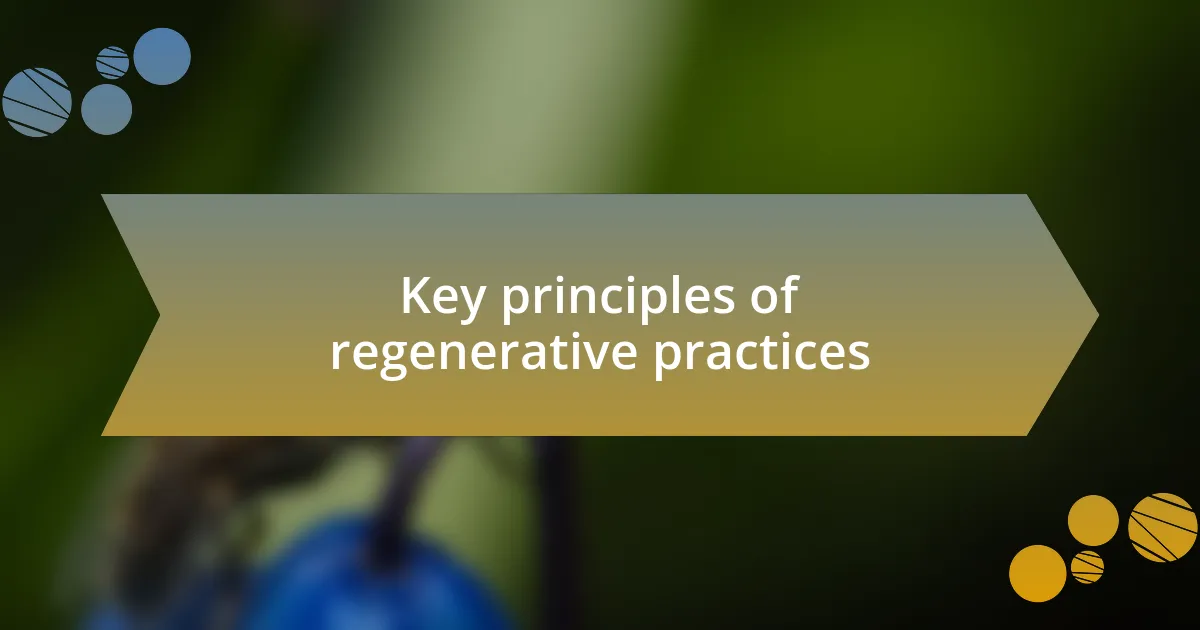
Key principles of regenerative practices
Key principles of regenerative practices focus on restoring and enhancing the soil, biodiversity, and ecosystems. One principle that really resonates with me is the emphasis on soil health. For years, I watched as a local farm transitioned away from chemical fertilizers. The difference was palpable; not only did the crops flourish, but the community also saw an increase in beneficial insects and wildlife. How often do we consider the intricate relationships beneath our feet?
Another crucial aspect is the practice of crop diversity. I once volunteered on a farm that practiced polyculture—growing multiple crops in one area. The visual beauty of those fields was stunning, but more importantly, it taught me how diverse planting can prevent pests and diseases. It’s fascinating to think that nature has its ways of maintaining balance if we just let it do its work.
Lastly, integrating livestock into farming systems is a key regenerative practice. I remember a farm tour where the owner explained how grazing animals contribute to soil fertility through natural manure. He made a compelling case for how we can use livestock not just for food, but as partners in restoring land. Isn’t it amazing how interconnected all these elements are in the pursuit of sustainability?
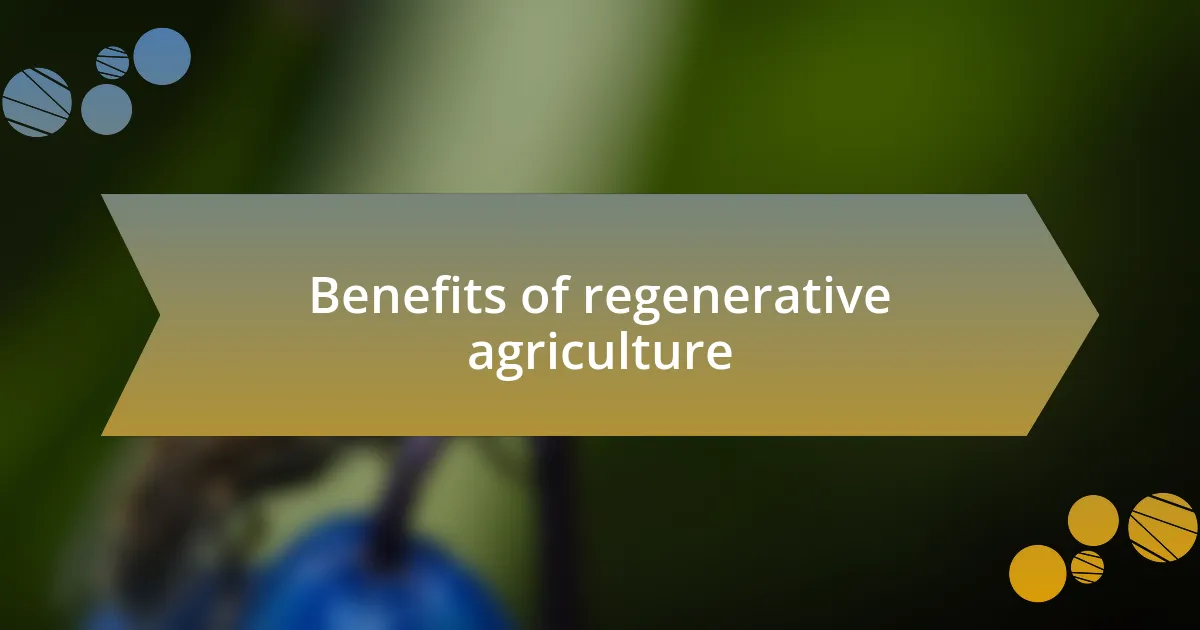
Benefits of regenerative agriculture
The benefits of regenerative agriculture are profound and far-reaching. I recall visiting a regenerative farm where the owner proudly shared that they had increased their yields while using fewer chemical inputs. It was incredible to see how healthy the soil was, teeming with life, which not only produced bountiful crops but also helped sequester carbon. Can you imagine the positive impact that could have on climate change?
Another striking advantage of regenerative practices is the enhancement of ecosystems. I’ve experienced firsthand how these methods promote greater biodiversity, fostering habitats for various species. One afternoon spent on a farm surrounded by vibrant wildflowers made me realize that supporting pollinators isn’t just beneficial for the plants; it’s a critical component of a thriving environment. What if more farms adopted this approach, creating landscapes bursting with life?
Moreover, regenerative agriculture can strengthen community resilience. I remember a community gathering discussing local food systems and how one farm’s sustainable practices had inspired others to follow suit. The idea that we can build a network of support, driven by shared values of sustainability, resonates deeply with me. Could forming such connections not empower us to tackle larger environmental challenges together?

My experiences with regenerative techniques
I remember the first time I tried cover cropping on my small plot of land. After planting a mix of clover and rye, I was surprised by the vibrant green carpet that emerged. Walking through it, I felt a sense of connection with nature, knowing that I was improving soil health while preventing erosion. It was as if the earth was thanking me for giving it a break.
On another occasion, I experimented with agroforestry, integrating trees into my cropping system. Watching young trees grow alongside my crops created a micro-ecosystem that felt alive. I observed more birds and beneficial insects, and the shade they provided made the summer heat more bearable for both my plants and me. Isn’t it astonishing how a simple change in planting strategy can create such a harmonious balance?
My experience with rotational grazing was equally enlightening. By moving livestock between different pasture sections, I witnessed not just improved grass growth, but also happier animals. The fresh pastures seemed to energize them, and their well-being was a reminder that our farming practices impact not only the land but also the creatures living on it. How can we ignore such a clear indication that nature rewards us when we treat it with respect?
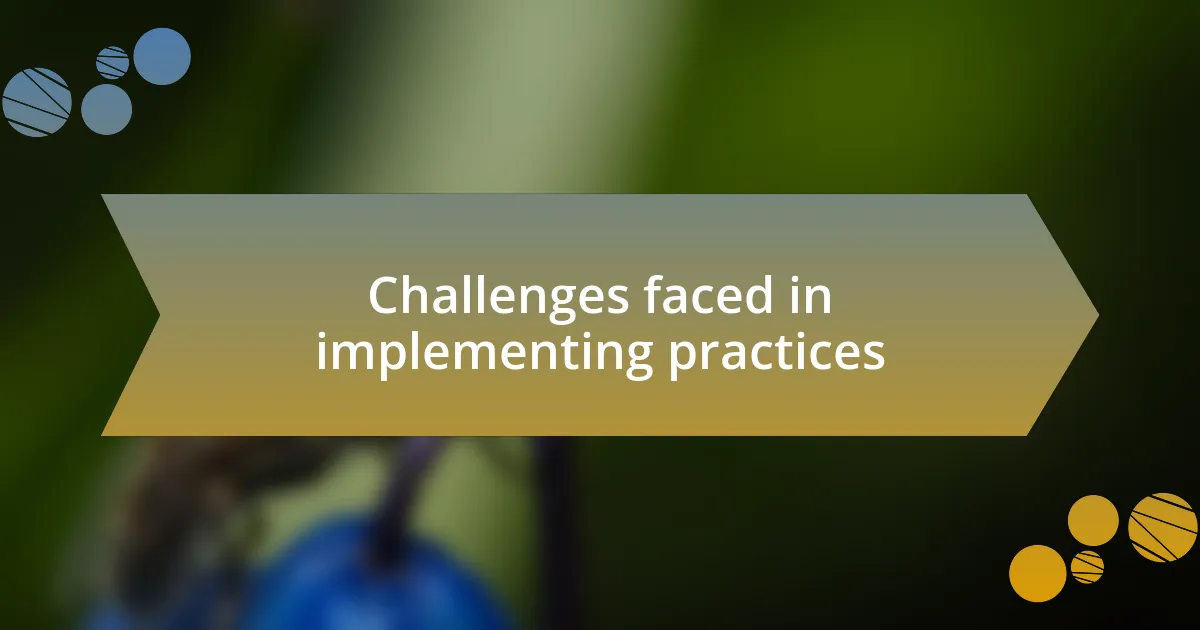
Challenges faced in implementing practices
Implementing regenerative agriculture practices isn’t without its hurdles. One of the most significant challenges I faced was the initial investment of time and resources. The transition from conventional to regenerative methods often requires a willingness to learn and adapt, which can be daunting for those rooted in traditional practices. I remember feeling overwhelmed by the sheer amount of information I needed to absorb. How many farmers are willing to take that leap?
Another obstacle I’ve encountered is the resistance from the surrounding community. When I started practicing no-till methods, some neighbors were skeptical, questioning the effectiveness and long-term benefits. It was disheartening to see doubt in their eyes, especially when I was excited about the potential for healthier soils. But then I realized that change often meets resistance, and it takes a community effort to shift perceptions. Have you ever faced skepticism when trying something new?
Lastly, weather unpredictability presents a constant challenge. During one growing season, I was thrilled to see my cover crops thriving. However, a late-season drought impacted my plans significantly, reminding me that nature plays a powerful role in agriculture. It’s crucial to build resilience into our practices, but it can be hard to accept that sometimes, despite our best efforts, the outcome is beyond our control. Have you ever poured your heart into something, only to be confronted by forces you couldn’t predict?
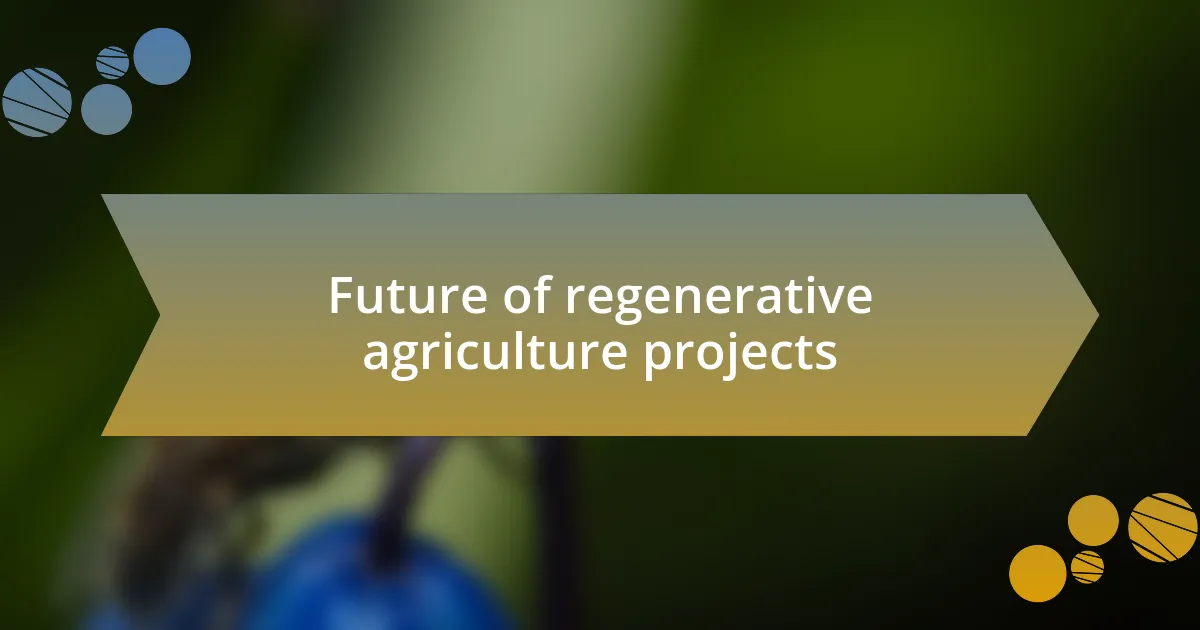
Future of regenerative agriculture projects
The future of regenerative agriculture projects looks promising, yet it will require a collective effort for success. I envision a landscape where farmers, researchers, and consumers actively collaborate to create innovative solutions. For instance, imagine community workshops where knowledge is shared openly, allowing those of us interested in regenerative practices to troubleshoot together. Have you ever thought about how empowerment through education could transform agricultural landscapes?
As technology continues to evolve, the integration of digital tools will shape regenerative agriculture’s future significantly. Picture using data analytics to monitor soil health or employing drones to assess crop vitality. From my experience, tools like these can revolutionize how we approach farming, making it more efficient and responsive to real-time conditions. Isn’t it exciting to think about the possibilities that lie ahead?
Moreover, I believe that consumer demand for sustainable products will drive the expansion of regenerative practices. I once switched to a more environmentally conscious diet, which opened my eyes to the impact of my choices. As consumers become increasingly aware of how products are sourced, I can see a future where regenerative agriculture is not only a niche but a standard for food production. How will our purchasing power shape the land we cultivate?